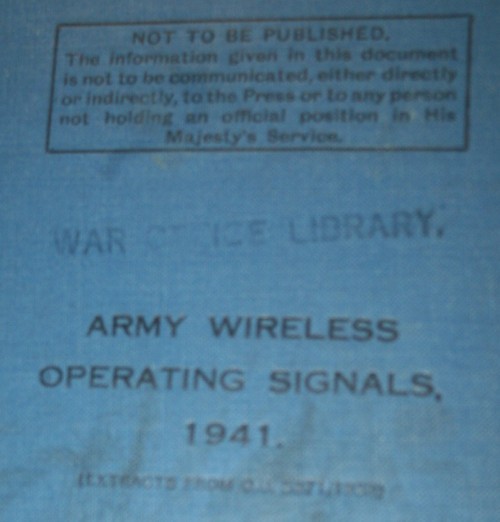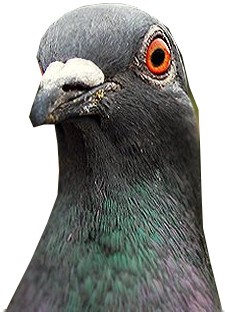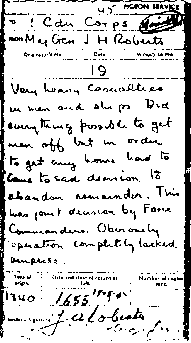According to Stu Rutter’s latest raid on the National Archives, the Allies’ WW2 “Typex” cipher used a single five-letter indicator, placed both at the start and end of messages [so says WO 208/5109, anyway]: and so he concludes that Typex was very probably the system used by our wonderfully mysterious WW2 pigeon cipher. Having said that, I do wonder whether the first five plaintext letters will turn out to be “QQQQQ”, as I recall that many messages had this dummy text group added at the start to avoid stereotyped messages, even though it was itself an even more stereotypical sequence. Perhaps combining this with the ciphertext might let us work back to the rotor contents and settings… just a thought!
[Typex remains a great working hypothesis, though personally I’d still like to see how the Air Support Syllabic Cipher (War Office document BX 724) and Royal Engineer Syllabic Cipher (War Office document BX 724/RE) worked. But that’s another story!]
Intriguingly, GCHQ’s archives holds a Typex document which Stu would understandably like to get access to: and at last weekend’s Big Bang Science Fair at London’s ExCel venue (which my son thought was really fantastic), I was very pleasantly surprised to bump into the GCHQ Historian hard at work on the GCHQ stand, busily helping children encipher their own Enigma messages for Bletchley Park’s rebuilt Bombe to try to crack. He told me that GCHQ releases documents more according to security-related criteria than in response to Freedom of Information requests: and even though he would send us through the appropriate paperwork to fill out, we should necessarily be somewhat patient… it’s no secret that it’s not the fastest of processes (for example, they released the last Enigma file only last year). Fingers crossed that all goes through!
Incidentally, the Americans didn’t think Typex was properly fit for purpose, sniffily describing it as “nothing but a glorified German Enigma, with 5 rotors instead of 3 and with arrangements for printing” (NARA: RG 457 HCC Box 804 NR 2323, quoted in Ratcliff “Delusions of Intelligence”, p.167), while British cryptologists also saw flaws in Typex “as early as 1940”, though their recommendations as to how to work around them seem to have been acted upon (“Delusions”, p.179). Yet even though the Germans knew exactly how Typex worked, they had “abandoned work on it” prior to 1942, presumably because of its structural similarity to their own ‘unbreakable’ Enigma variants (“Delusions”, p.178 and p.202).
But here’s something to do with Typex that’s rather interesting (and more social history than overtly cryptographic) which I liked, and think you may well like too. 🙂
Having posted a few days ago on the British Army’s pervasive use of ciphers for pigeon messages, I was intrigued to read about the Army “cipher room” at Arundel Castle mentioned by Bill Button: and so decided to snoop around the web for further mentions of WW2 cipher rooms. The nicest things I dug up by far were three reminiscences made by Jessie Dunlop in 2004 (courtesy of her daughter Ann Wild) on the BBC’s “People’s War” website. Rather delightfully, these described her wartime cipher experiences, firstly at Low Grade Cipher School in Eccleston Square, secondly at High Grade Cipher School in Half Moon Lane, London, and then finally at SHAEF Supreme headquarters in an Underground tunnel between Goodge Street and Warren Street Station, at which time she met her future husband Jack.
Confusingly, she misremembered Typex as “xyco” (which is why these posts didn’t show up in web searches), but that’s entirely to be expected – it was a very long time ago, after all. In a follow-up comment from 2004, she further described how xyco / Typex was used:-
“I think it was modelled on the Enigma. It had several drums in the top with a lid to be lifted to reach these. The first one was static and was set each day with the beginning of the day’s code. The rest were also set each day but they revolved. A keyboard like a typewriter was below these and on this the message was typed in. It came out in groups of letters, I think. Sometimes we could add what was called a scrambler, an electrical gadget which we plugged in if the the message was top secret. This was indicated at the end of the message in the code.”
And so it would seem that in the pigeon cipher, we’re looking at
* an enciphered Army message (quite possibly in Typex);
* not sent during Operation Overlord (i.e. not on D-Day or shortly after); and
* not top secret (and hence not using any kind of scrambler).
This is really useful, because it probably means that Stu Rutter need not worry about scramblers or reflectors (I think): for if we are looking at a non-top-secret Typex message, it probably wasn’t using a scrambler. So as long as he has an accurate copy of the the contents and structure of the rotors and the way the Typex worked, who’s to say that Stu’s JavaScript simuator won’t be able to give us the answer? If so, it might arguably be the first Typex message ever decrypted by anyone… and how cool would that be? 😉
Incidentally, one great sanity check might be to ask the Royal Signals Museum in Blandford, Dorset if they could use their Typex machine to encipher some test messages with various rotor settings to validate Stu’s simulator. In return, perhaps they might like to have his simulator on display next to their machine, so that visitors can try it out for (virtually) real? That would be good for everyone, I think. 🙂
Anyway, here’s a question for you all: how can we find out if Jessie Dunlop – or indeed anyone else who worked on British Army High Grade Ciphers, whether in SHAEF or elsewhere – is still alive? Perhaps having her looking at our pigeon message might trigger some memories of how it all worked. Something to think about! 🙂









